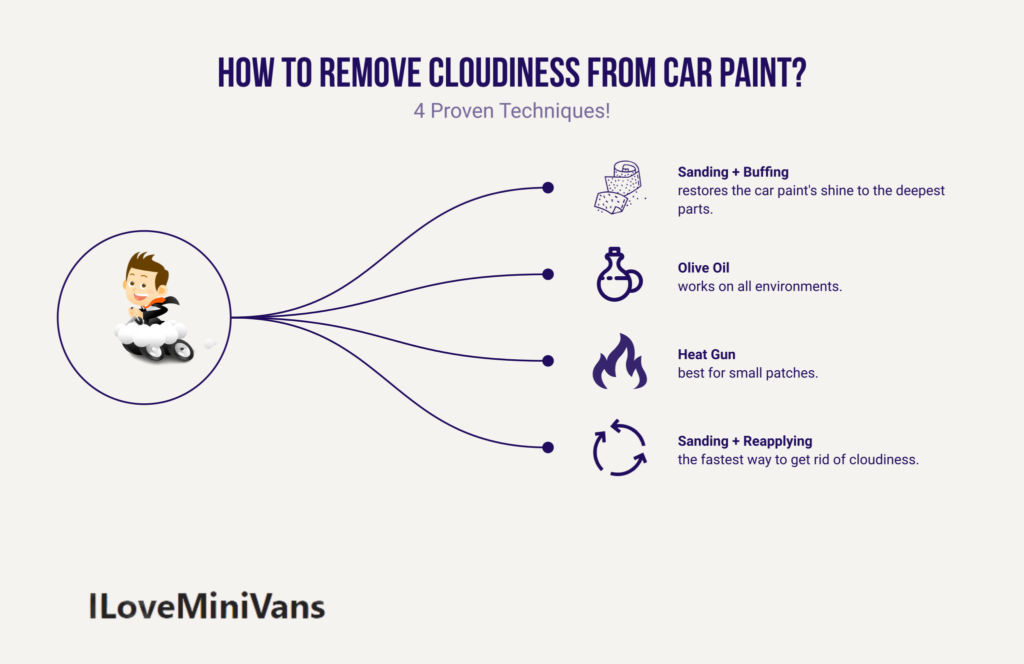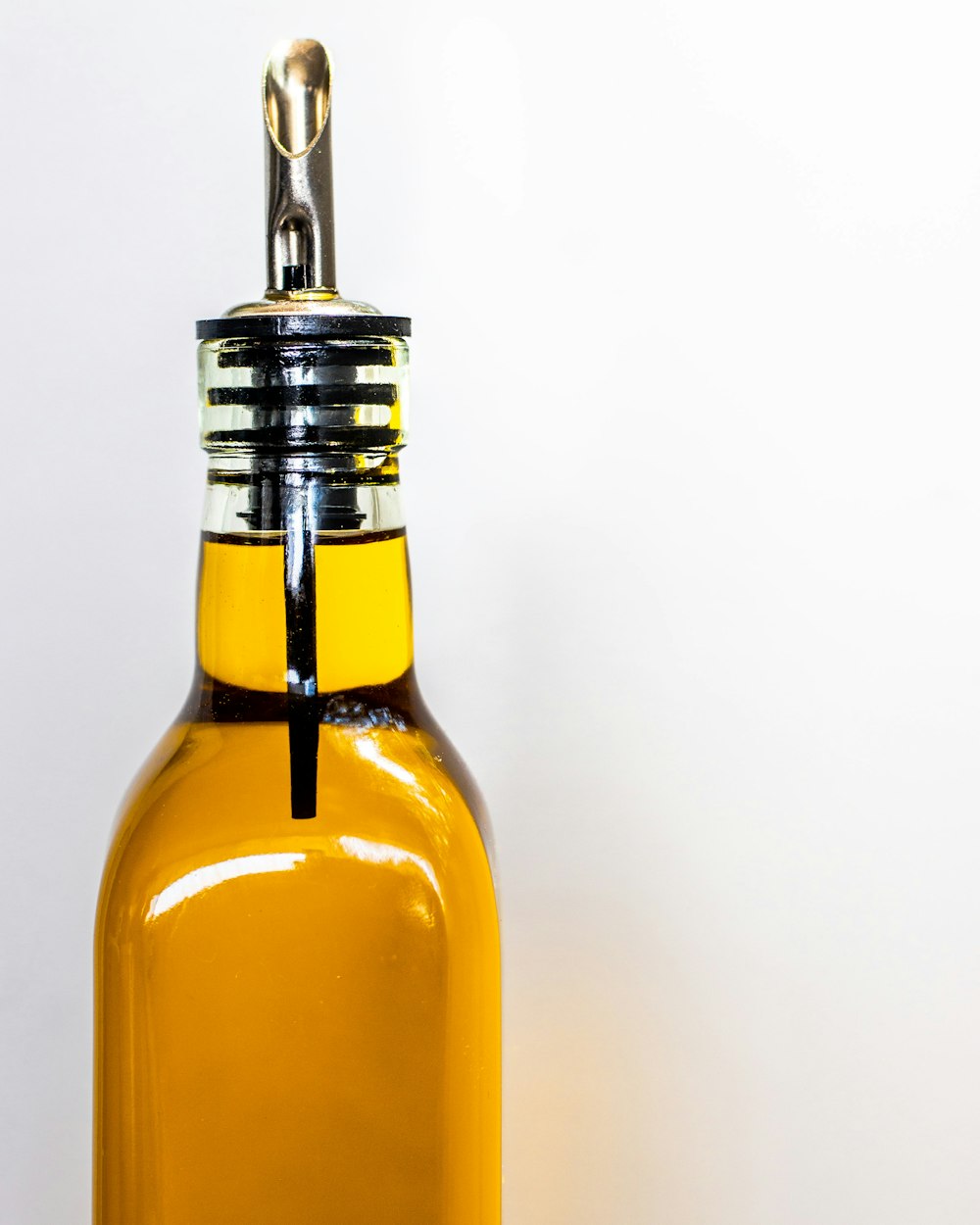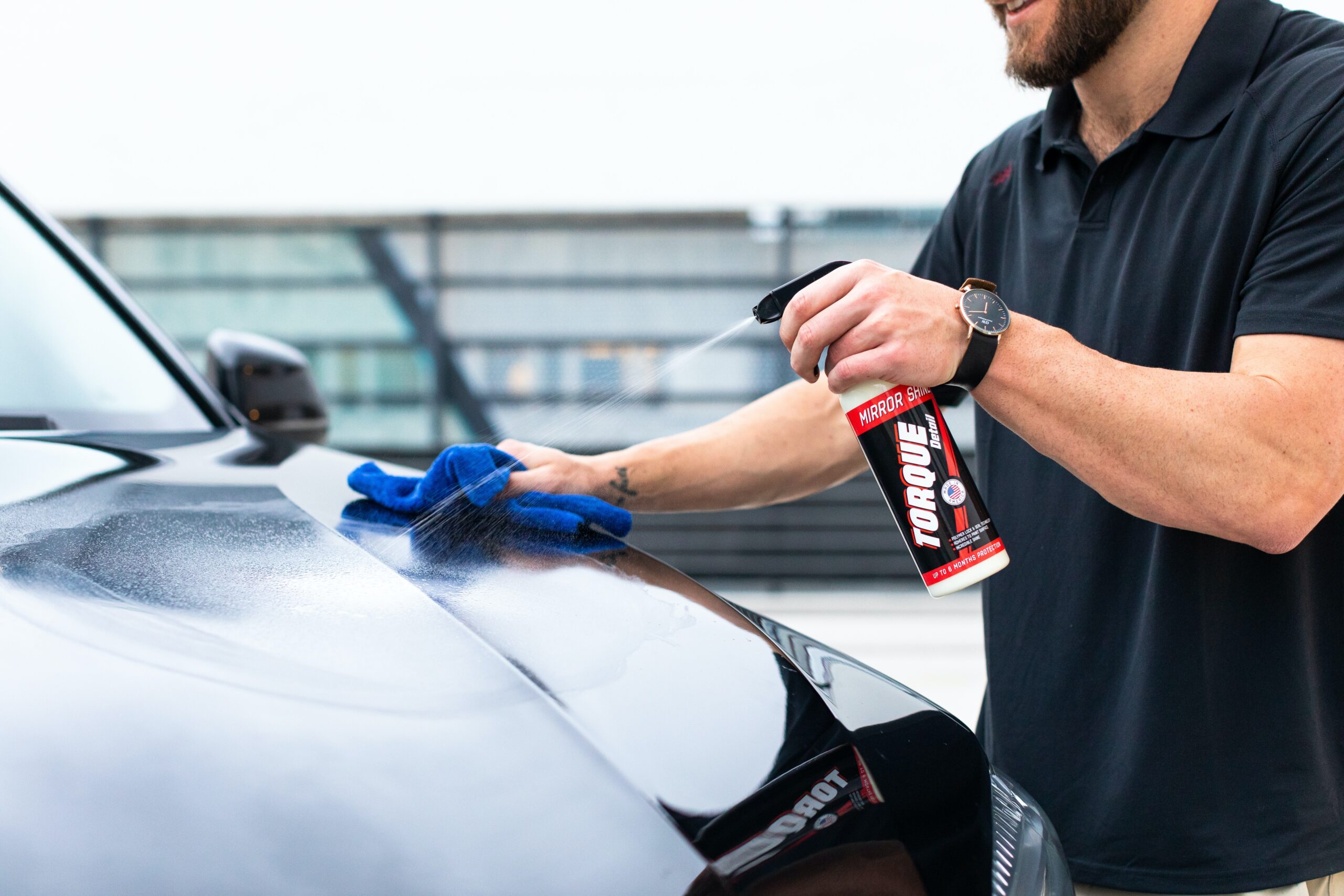Cloudiness on car paint can be disappointing, especially after all the effort of painting the vehicle. Luckily, anyone with our without experience can remedy this with ease. So, after sanding and repainting, you may wonder, how to remove cloudiness from car paint?
From the classic buffing and sanding technique to the unusual olive oil method, I’ve discussed the best ways to remove cloudiness from car paint. Plus, how to prevent cloudiness from happening in the first place!
What is Cloudiness on Car Paint?

Cloudiness or clouding in car paint refers to a repainting defect caused by humidity. It only affects the exterior, so you may need to clean your car’s interior if your windows look cloudy.
These can appear as stains or streaks in the finish paint coat with varying shapes. Also, the car paint will have some irregularities in color intensity. As a result, you get lighter and darker shades throughout the car—resembling a cloud.
Aside from that, since humidity adds an extra layer of moisture to a car, it may affect the paint. When you apply a clear coat over the vehicle, it’ll create a cloudy or milky façade.
Regardless, it forces you to repeat the work process to repair the intermediate coats.
As I mentioned earlier, cloudiness occurs due to excess exposure to humidity. But it may also happen when you don’t correctly time the application of a clear coat. For instance, cloudiness may occur if you paint your car during the day and under the blazing sun. The chances are higher than during the afternoon or evening.
That’s why manufacturers instruct users to apply the coat at room temp with no humidity. After all, these are the two main culprits of cloudiness on car paint! So, remember, to achieve a cleaner and cloud-free coat, keep the humidity and temperatures down a notch. This way, you can prevent cloudiness early on.
How to Remove Cloudiness From Car Paint? 4 Proven Techniques

Here are the best methods to fight the cloudiness of car paint and restore its original shine:
Sanding + Buffing Technique.
The best remedy to remove cloudiness from car paint is the sanding and buffing technique. It’s the most efficient and famous option to correct the cloudiness of your car. It involves wet sanding the vehicle and buffing it before clear coat reapplication.
Here’s how you can perform the sanding and buffing technique:
- Prepare the sandpaper. Wet your sandpaper by soaking it in clean, plain water for at least one hour. Doing this lubricates the sandpaper, giving you a neater finish.
- Have a backup spray bottle. If your soaked sandpaper dries out, it’s best to prepare a spray bottle with water beforehand. It ensures your sandpaper stays wet during the sanding process.
- Start sanding the affected areas. It’s best to start with 400 grit sandpaper and work your way up to 1,200 grit. Doing it this way ensures a consistent pattern and a clean finish.
- It’s buffing time. Once you’ve sanded your entire car, it’s time to begin buffing/polishing it. This step involves using loose abrasives such as a buffing wheel.
Remember, the goal of the sanding and buffing method is to scuff up affected surfaces and fill them in. As a result, you should get a high-quality and mirror-like shine. Your car should look good as new in no time.
The only downside to this is that it requires you to sand down your car several times. It’s best to follow this as it yields the best results. But you’ll need to sacrifice a bit of time as it can take a while to wet sand the entire car several times. So, if you want a quick fix to the cloudiness, check out the other methods!
Still, this method is worth the extra effort and time. After all, it has the highest success rate in removing cloudiness from car paint.
Explore the Olive Oil Method.

Yes, this technique involves the olive oil you’d usually use for cooking. Dubbed the “olive oil method,” this is best for removing stubborn cloudiness from car paint. It’s an anecdotal technique spread around automotive forums for a while now. And even if it hasn’t received mainstream attention, it works pretty well.
But remember that this isn’t a supported option for fixing cloudiness from car paint. Still, it’s worth trying as it’s harmless, cheap, and does its job.
Here’s how you can apply the olive oil method:
- Spread the olive oil. Apply some of it to the affected areas and let it sit for a couple of minutes. I suggest leaving the oil for at least an hour for the best results.
- Rinse the oil off. After the allotted time, rinse the olive oil off with clean, plain water.
- Add a second layer of clear coat to the fixed areas. Reapply a thin layer of clear coat on the places you’ve worked on.
At this point, the olive oil should have removed all impurities that caused the cloudy coat.
But what stood out about this technique is that it works in all environments. It isn’t dependent on humidity, so you can use it to remove cloudiness from car paint any time—and anywhere. Still, before adding the new clear coat, you need to apply it at room temp with no humidity. Doing it this way ensures the best results.
Use a Heat Gun for Small Patches.

Using a heat gun is best for removing cloudiness from your car paint in small patches. It’s efficient and easy to do, but it’s only ideal for tiny affected areas. So, if you’re looking for a technique that can get your whole car fixed, go for sanding and buffing.
Anyway, here’s how you can remove cloudiness from car paint with a heat gun:
- Get the right heat gun. You’ll need a heat gun with different heat settings. If not, you’re risking blistering your car’s paint.
- Clean the affected areas. Wipe off any dust, debris, or other impurities on your car to avoid burning them with the heat gun.
- Start working on the clouded parts. Switch your heat gun to the lowest setting and begin moving it back and forth on the affected spaces.
This technique slowly heats all the moisture from the car paint, removing the cloudiness. Although this can be time-consuming, its results are 100% worth it. And after some time, the cloudiness should fade away completely.
Once the cloudiness is gone, take the heat gun off and leave your car to cool at room temperature with no humidity. It’s crucial to maintain these conditions to avoid further issues.
Keep in mind that you need to use low heat and move the heat gun back and forth the entire time to avoid overheating. You can’t put the tool on too high or idle it in one spot for too long as it can damage your car paint more. So, there’s no shortcut to this method.
Try out the technique below if you’re looking for a faster remedy! But if you don’t mind committing some time to it, using a heat gun should be enough.
How to Remove Cloudiness From Car Paint Quickly? Sand it Down and Reapply.
Finally, sanding is the last and fastest way to remove cloudiness from car paint. It has become famous among experts as it works for clear car coating and other areas like painting.
When your car paint looks unappealing, you can sand it down with fine sandpaper (>200 grit). And after, reapply your preferred paint color.
Regardless of how bad the cloudiness is in your car paint, always stick to fine sandpaper with at least 200 grit. I also recommend using an electric sander to avoid uneven pressure, keeping your car safe.
Aside from that, it prevents arm fatigue that may affect how evenly you’re sanding the vehicle.
Also, like with sanding and buffing, ensure you’re not penetrating the car paint. Or else, you’re risking damaging the coat underneath as well. Remember, we only need to sand off the surface layer of the car paint.
I suggest rubbing the car paint with denatured alcohol to wipe off the remaining dust, dirt, and other debris that might get trapped in the coat. It gives you cleaner and more consistent results!
Once sanding down your car, clean the surface with plain water and let it dry. Also, like most of the listed techniques, move the vehicle to a cool environment with no humidity. And after your car completely dries off, reapply the clear coat once more.
How to Prevent Cloudiness From Car Paint?
Here are six proven prevention techniques to avoid cloudiness in car paint:
✔️ Perform Regular Maintenance on Your Spray Gun to Avoid Cloudiness Early On.
To prevent paint defects during the painting process, regularly maintain your spray gun. Clean the tool’s nozzle and paint nails often for optimal functioning. Aside from that, when applying complex car paint colors, test out the spray gun’s fan pattern first.
Doing these reduces the chances of cloudiness in your car paint early on.
✔️ Always Apply a Control or Effect Coat to Prevent Cloudiness in Complex Car Paint.
Some car paint hues can be complex, like those in metallic or pearly variations. These present a more significant challenge for the bodywork painter to keep up with or match. It’s best to apply a control or effect coat to optimize the placement of the complex particles from those hues.
This extra coating layer helps these complex particles distribute evenly, preventing cloudiness.
✔️ Position the Spray Gun In Line with the Part.
One of the main culprits of cloudiness in car paint is the incorrect position of the spray gun in line with the part. Always place it perpendicular to the par for a more even and consistent application. This way, you can ensure you’re always performing the correct distribution of pigments.
✔️ Maintain a Single Layer of Coating.
If you don’t apply the correct technique for paint application, overlapping of coating may happen. And during this, you risk going over the layers between application areas. As a result, your car paint gets a cloudy appearance. So, try to maintain a single coating layer and keep each paint streak close to the other.
Frequently Asked Questions
Q: Why does my car paint look cloudy?
A: Many things can make car paint look cloudy, but the main culprit is oxidation. It appears as a chalk-like residue on the vehicle’s surface, resulting in cloudiness. Sometimes, oxidation may also cause severe fading of the car paint. Oxidation mostly happens because of prolonged exposure to outdoor elements over time.
Q: How to remove cloudiness from car paint fast?
A: The fastest way to remedy cloudiness from car paint is by sanding down the affected areas. Ensure to sand these spots down to their intermediate coats to remove all cloudiness. But before you sand down your car paint, insulate those parts with filter paint for the best results. Finish things off by applying colored paint and a clear coat.
Q: Is it possible to make faded or cloudy car paint shine like new?
A: With patience and the right tools, anyone can make severely clouded or faded paint shine like new. Using heavy polish, you can remove all the problem areas, including stains and water spots. And to finish things off, I recommend using a quick hand buffing to restore the paint to its original shine.
Q: How can I make a car with cloudy/faded car paint shine without wax?
A: You may use a hair conditioner to shine your car, thanks to the chemicals silicone and lanolin. It’s a foolproof alternative that’s easy and fast to do. So, although waxing is one of the best ways to remedy cloudiness from car paint, it can be time-consuming and expensive. Grab your hair conditioner and scrub down the affected areas, and your car will be shining like new in no time.
Q: Does the cloudiness of a clear coat of car paint go away?
A: You can make the cloudiness from any car paint go away with a bit of sanding and re-clearing. But it won’t disappear on its own, so you’ll need to make an effort to fix it.
Final Words
While removing cloudiness from car paint can be a hair-pulling experience, that doesn’t mean you have to sit through it! How to remove cloudiness from car paint? From sanding and buffing to using a heat gun, these are techniques you can explore. These easy-to-do DIY techniques can help you get back your car paint’s original shine in no time.

